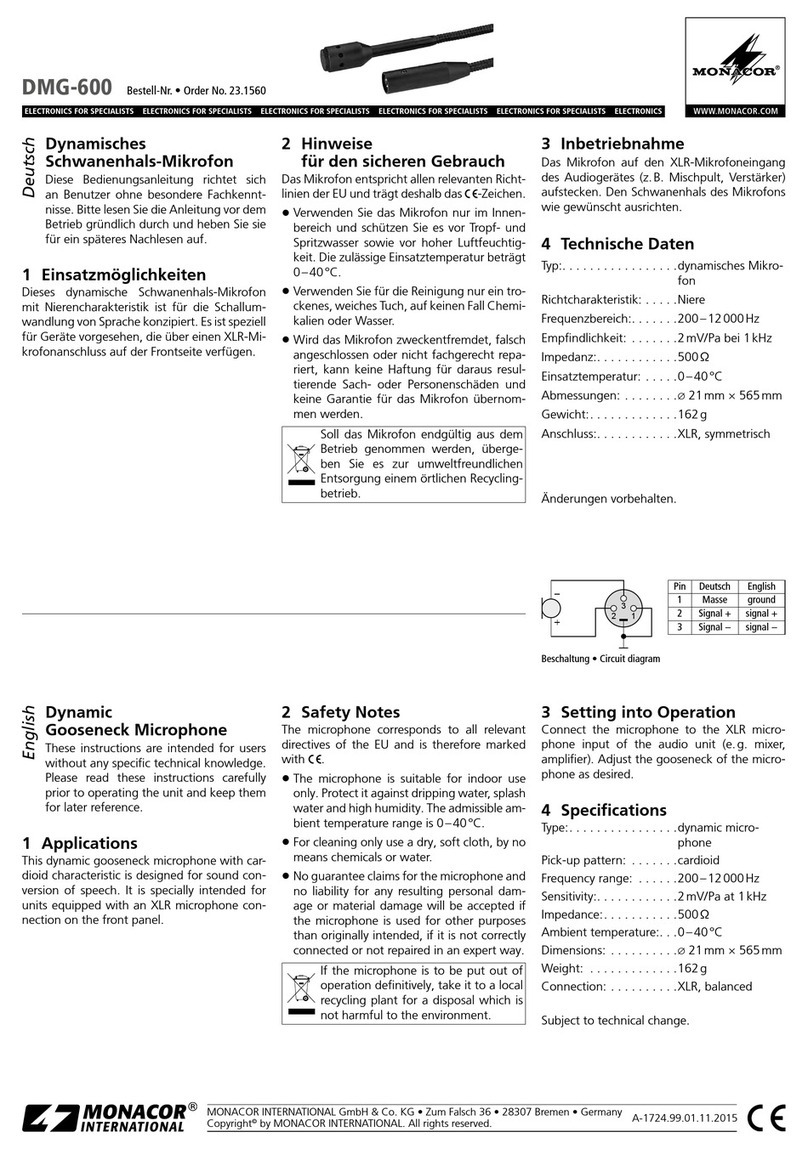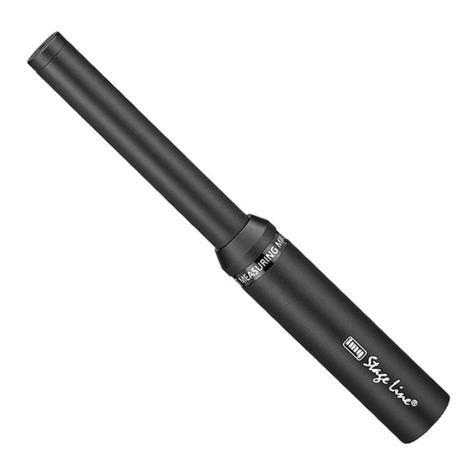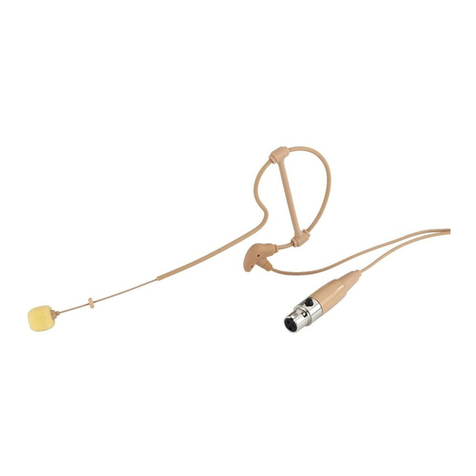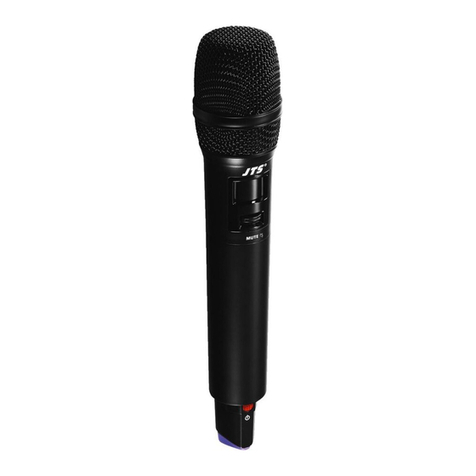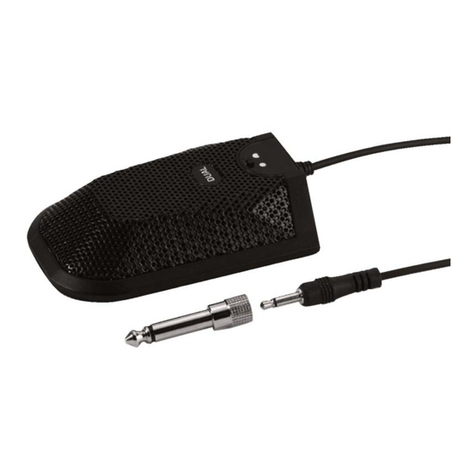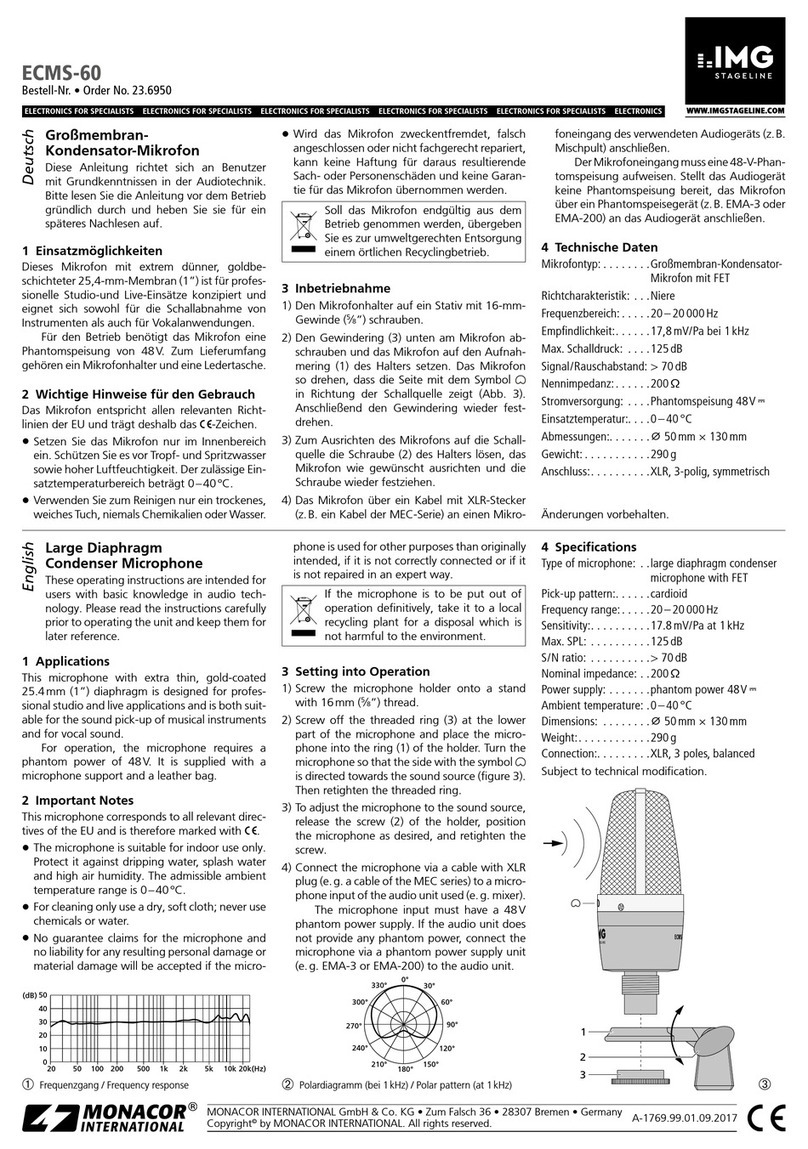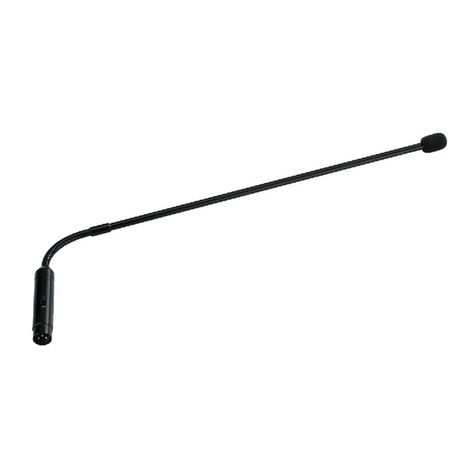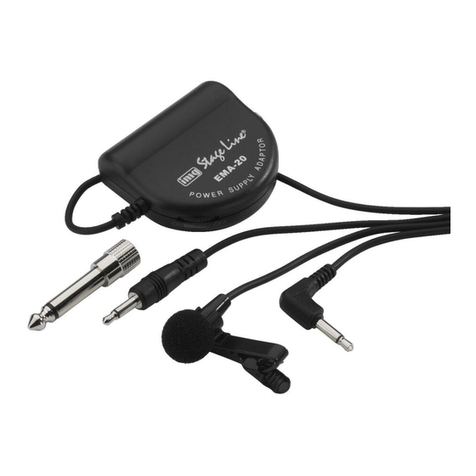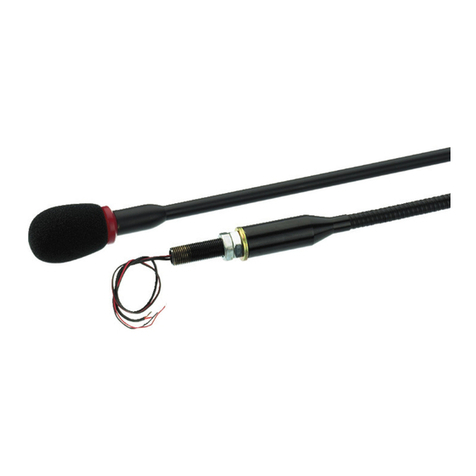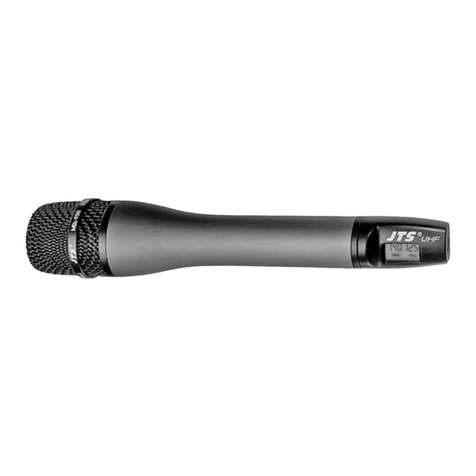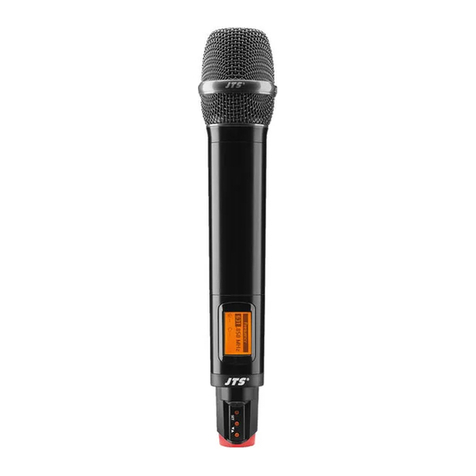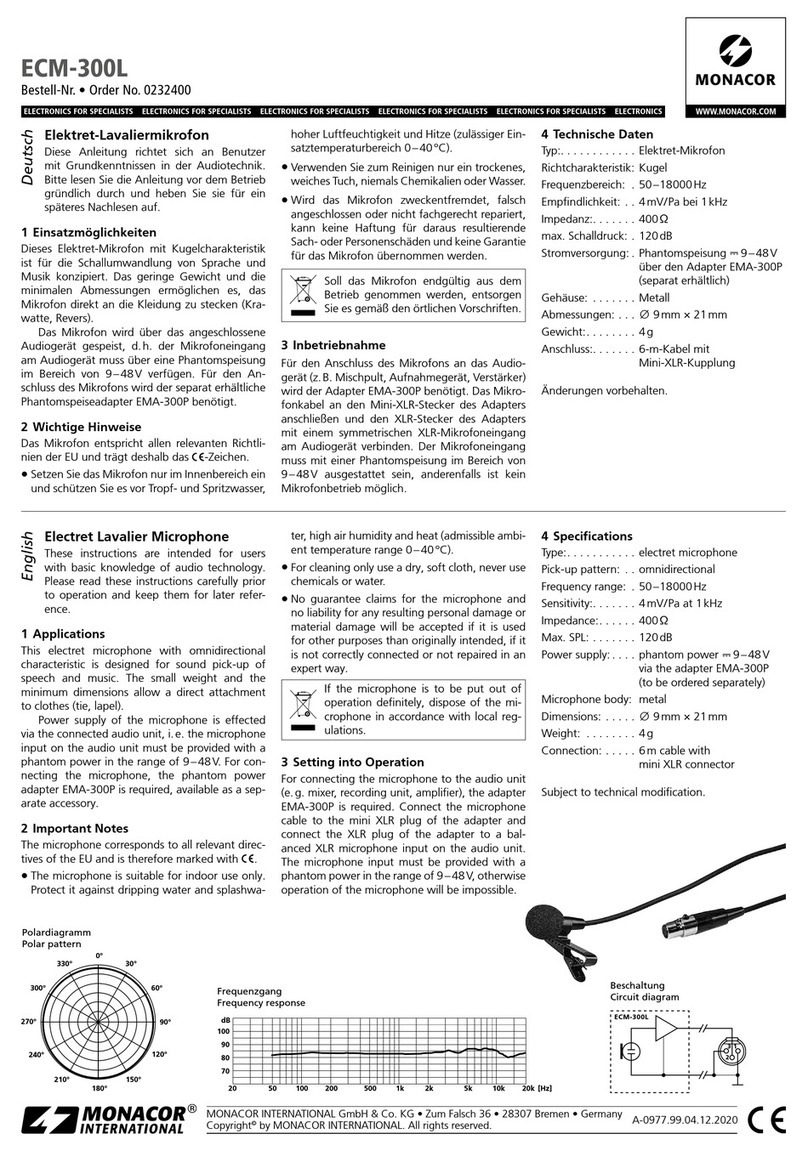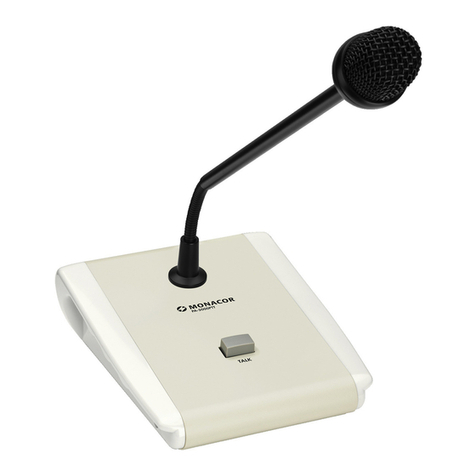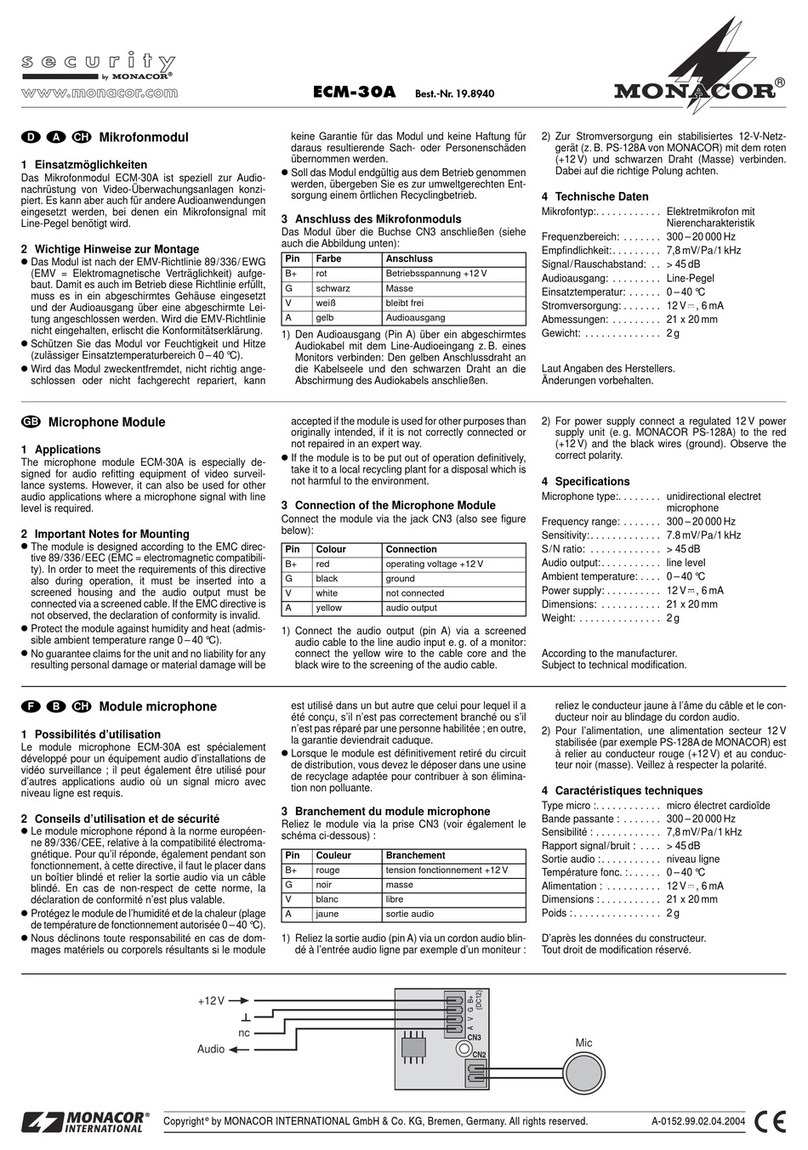Microphoneélectretstéréo
Possibilités d’utilisation
Ce microphone électret stéréo léger de technologie
X/Y est particulièrement bien adapté pour des appli-
cationsdediscourset d’enregistrementsamateur.Ilest
livré avec deux pinces micro, une base pour constituer
un pied de table et deux cordons de branchement.
Conseils d’utilisation et de sécurité
Lemicrophone répondàla normeeuropéenne89/336/
CEE, relative à la compatibilité électromagnétique.
●Le microphone n’est conçu que pour une utilisation
en intérieur. Protégez le microphone de l’humidité
et de la chaleur (plage de température de fonction-
nement autorisée 0–40°C).
●Pour le nettoyer, utilisez uniquement un chiffon sec
et doux, en aucun cas de produits chimiques ou
d’eau.
●Nous déclinons toute responsabilité en cas de
dommages matériels ou corporels résultants si le
microphone est utilisé dans un but autre que celui
pour lequel il a été conçu, s’il n’est pas correcte-
ment branché ou s’il n’est pas réparé par une per-
sonne habilitée ; en outre, la garantie deviendrait
caduque.
●Lorsque le microphone est définitivement retiré du
circuit de distribution, vous devez le déposer dans
une usine de recyclage adaptée pour contribuer à
son élimination non polluante.
●Ne jetez pas les batteries usagées dans la poubelle
domestique mais dans une poubelle adéquate
(ramenez-les p.ex. à votre détaillant).
Mise en service
1) Desserrez l’anneau fileté (3) situé à la base du
micro et retirez le corps (2). Le compartiment batte-
rie sur la face arrière est désormais accessible.
Insérez une batterie 1,5V de type R6 dans le com-
partimentselon les indicationsmentionnées dansle
compartiment batterie et remontez le micro.
En cas de non-utilisation prolongée (supérieure
à une semaine p.ex.), retirez la batterie pour éviter
qu’elle ne coule et n’endommage l’appareil.
2) Deux pinces sont livrées pour la fixation du micro :
la plus petite pince possède un adaptateur avec
filetage (6,35mm/1/4") et peut être fixée ainsi par
exemple sur un camescope. La pince plus grande
peut être vissée via sa vis d’adaptation sur un pied
micro avec filetage 9mm (3/8") ou sur la base
livrée pour former un pied de table.
Les deux pinces peuvent également être vis-
sées sur un pied avec un filetage 16mm (5/8"):
pour ce faire, sur la plus petite pince, retirez l’adap-
tateur fileté ou sur la plus grande, retirez la vis d’ad-
aptation et vissez la pince directement sur le pied.
3) Reliez le microphone via le cordon spiralé 40cm
ou le câble de 3m à l’appareil suivant (par exem-
ple camescope, enregistreur de mini-disques).
Mettez toujours l’extrémité du câble avec le ver-
rouillage à vis (4) dans la prise sur le micro et vis-
sez pour empêcher que l’on ne retire la fiche pen-
dant le fonctionnement.
4) Allumez le micro avec l’interrupteur (1) et simul-
tanément sélectionnez le mode de fonctionnement :
interrupteur sur position médiane MO : mode mono
interrupteursur positionsupérieur ST: modestéréo
Si l’interrupteur est sur la position inférieure OFF,
le micro est éteint.
Caractéristiques techniques
Directivité . . . . . . . . . . . cardioïde
Bande passante . . . . . . 50–16000Hz
Sensibilité . . . . . . . . . . . 5,6mV/Pa à 1kHz
Impédance . . . . . . . . . . 680Ω
Pression sonore max. . . 110dB
Rapport signal/bruit . . . 57 dB
Alimentation . . . . . . . . . batterie 1,5V, type R6
(non livrée)
Dimensions, poids . . . . 33 x 31 x 142mm, 70g
Branchement . . . . . . . . jack 3,5, stéréo
D’après les données du constructeur.
Tout droit de modification réservé.
Microfono stereo all’elettrete
Possibilità d’impiego
Questo leggero microfono stereo all’elettrete in tecno-
logiaX/Y,è particolarmenteadattoperapplicazionicon
lingua parlata e per riprese amatoriali. Il kit comprende
due supporti per microfono, una base per costruire uno
stativo da tavolo nonché due cavi di collegamento.
Avvertenze di sicurezza
Il microfono è conforme alla direttiva CE 89/336/CEE
sulla compatibilità elettromagnetica.
●Usare il microfono solo all’interno di locali e proteg-
gerlo dall’umidità e dal calore (temperatura d’im-
piego ammessa fra 0 e 40°C).
●Per la pulizia usare solo un panno morbido, asciut-
to; non impiegare in nessun caso prodotti chimici o
acqua.
●Nel caso d’uso improprio, di collegamenti sbagliati
o di riparazione scorretta non si assume nessuna
responsabilità per eventuali danni consequenziale
a persone o a cose e cessa ogni diritto di garanzia
per il microfono.
●Se si desidera eliminare il microfono definitiva-
mente, consegnarlo per lo smaltimento ad un’istitu-
zione locale per il riciclaggio.
●Non gettare le batterie scariche nei rifiuti di casa
bensì negli appositi raccoglitori (p.es. presso i ri-
venditori).
Messa in funzione
1) Svitare l’anello (3) dalla parte inferiore del micro-
fono e togliere il corpo del microfono (2). A questo
punto è accessibile il vano batteria sul retro. Inse-
rire una batteria stilo 1,5V (AA) come indicato nel
vano batteria, e rimontare il microfono.
Nel caso di non utilizzo prolungato (p.es. più di
una settimana), conviene togliere la batteria per
evitare che perda danneggiando il microfono.
2) Per il fissaggio del microfono sono allegati due
supporti: quello più piccolo ha un adattatore con
filettatura tipo macchina fotografica (6,35mm/1/4")
e può quindi essere fissato p. es. su un camcorder.
Con la sua vite adattatrice, il supporto maggiore
può essere avvitato su uno stativo con filettature di
9mm (3/8") oppure lo si può fissare sulla base per
creare uno stativo di tavolo.
Entrambi i supporti possono essere avvitati
anchesu uno stativocon filettaturadi 16mm(5/8").
In questo caso occorre svitare l’adattatore filettato
dal supporto minore oppure la vite adattatrice dal
supporto maggiore e avvitare il supporto diretta-
mente sullo stativo.
3) Collegare il cavo del microfono con l’apparecchio a
valle (p.es. camcorder, registratore MD) per mez-
zo del cavo spiralato di 40cm oppure del cavo di
3 metri. In ogni caso, inserire il terminale del cavo
con la sicura a vite (4) nella presa sul microfono ed
avvitarlo bene per evitare che il connettore si sfili
durante l’uso.
4) Accendere il microfono con l’interruttore (1) sce-
gliendo contemporaneamente la modalità di fun-
zionamento:
interruttore in posizione
centrale MO: funzionamento mono
interruttore in posizione
superiore ST: funzionamento stereo.
Se l’interruttore si trova in posizione inferiore OFF,
il microfono è spento.
Dati tecnici
Proprietà direzionale: . . a cardioide
Banda di frequenza: . . . 50–16000Hz
Sensibilità: . . . . . . . . . . 5,6mV/Pa a 1kHz
Impedenza: . . . . . . . . . . 680Ω
Pressione sonora max.: 110dB
Rapporto S/R: . . . . . . . 57dB
Alimentazione: . . . . . . . batteria stilo 1,5V (AA)
(non compresa)
Dimensioni, peso: . . . . . 33 x 31 x 142mm, 70g
Collegamento: . . . . . . . . jack 3,5mm stereo
Dati forniti dal costruttore. Con riserva di modifiche tecniche.
ECM-70ST
Best.-Nr. 23.3460
wwwwww..iimmggssttaaggeelliinnee..ccoomm
Copyright©by MONACOR INTERNATIONAL GmbH & Co. KG, Bremen, Germany. All rights reserved. A-0182.99.01.12.2003
®
